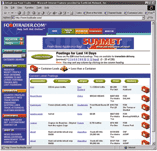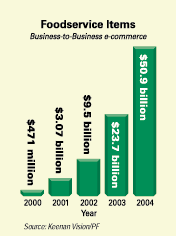
Not surprisingly, planning and training are key to any e-commerce activity. Michael Owens, vice president of marketing, logistics planning, purchasing at Robin Hood Foods, Markham, Ontario, found more work than expected to get to a clear position of what Robin Hood wanted to auction, as well as what percentage of ingredient requirements should be up for auction and how that might relate to current suppliers. New suppliers must be qualified, so a company may not want to put up a huge percentage of needs, while giving enough to make the online sourcing profitable and making sure the specifications are delivered accurately by the supplier.
"There was a fair amount of work by both the online exchange and Robin Hood Foods," Owens said. "None of that is computer/Internet friendly. The relationship (with the online exchange) led to putting Robin Hood's specifications and other criteria into an Internet-friendly format for communicating to bidders. This information is always there. The fully B2B web-based purchasing system will allow a full profile there and available."
Bob Schult, chairman and CEO of Novopoint, notes that to build understanding and trust with the supply side of the food industry takes about four meetings. "It is an education process--for people to really grasp it, how it can be implemented in their facilities and the benefits that can be gained. Trust is the key and takes a little time; they are dealing with mission-critical information. When you trust the people you're working with, the learning moves faster. When the learning moves faster, the savings move faster."
The savings can certainly be found. Owens reported success in the 10% range of money savings. "This is probably a better way of doing things," he noted, "particularly once the first (auction) is done."
The items auctioned have begun to expand, as evidenced by Heinz's recent reverse auction for advertising. Charles Lanphear, Heinz's media director, notes the company had previously purchased ingredients through e-commerce, but this was the first time for airtime.

Live on the Internet, participants could see other bids but not the bidder's identity. The 32-minute auction saw nearly 20 bids and saved Heinz about 15% versus conventional methods, Lanphear related. Heinz plans on continuing with e-commerce; based on advertising requirements.
Similar success has been found in nearly all areas of e-procurement. As of February 2000, the Quaker Oats Company had identified more than $8.5 million in savings on direct materials and services through the FreeMarkets online auction marketplace. (The $8.5 million represents the amount of savings the company achieved versus prices it had in place before going to FreeMarkets.) From 1997 through February 2000, Quaker had bid out more than $59 million worth of goods and services in both traditional and nontraditional spend categories through FreeMarkets and identified $8.5 million in savings on items such as food ingredients, packaging materials and services.
A Seller's Market?
Olin Thompson of Process ERP Partners related a number of concerns suppliers may face. "If it is so good to buy (online), what about the seller? That's not a pretty picture. The seller has to decide whether he wants to get on the bandwagon. If the buyer can save, he'll choose that option."In some ways, this has proven beneficial to sellers. Some have gotten buyers they could not reach previously. With many exchanges, suppliers can access a vast customer base and do not have to spend money finding buyers.
Thompson notes, "Tactically, the way they sell will change how to sell in that channel differently or to move faster in that channel to gain more share." A study by Boston Consulting Group suggests that sellers can actually benefit from participation in e-marketplaces. They can use the growing interest in online collaboration to better differentiate their products and service from those of their competitors, thus deepening customer relationships and resisting pressures on price.
Procuring Success
David Laukat, founder of ecFood.com, related one example. Multiple plants buying a product decided to aggregate into one purchase--one big buy--and saved 35% from what they had collectively been paying. Not all auctions are that successful, however. Some auctions, Schult noted, may even result in a higher price, but the key issue can be the time required. In addition, the auction can be quite educational.In another example noted by Laukat, a company was buying glass jars from a source having financial trouble. The company needed another supplier and took the order to auction, where the results were somewhat surprising. The incumbent supplier was 15% lower than others. The company learned a lot about their market situation. The supplier learned they could charge up to 15% more and saw a possible reason for the financial troubles.
Using ecFood.com in two purchaser auctions, Furman Foods realized a 15% savings in one auction and another 3% savings
in another. For the combined total of nearly 1.5 million pounds of beans, ecFood.com sourced the items, identified and enlisted suppliers, and established a fair market price using purchaser
auctions.

Procuring Online
The online auction process is fairly straightforward and similar among exchanges. Registered sellers anonymously post their products and prices online. Buyers view and bid on products through a secure channel on the exchange's website. With a few mouse clicks, qualified members have instant access to the online selection of product lots and potential trade partners, where they can negotiate with each other.Some exchanges have opted to focus on markets in the U.S., but Foodtrader.com has taken a more expansive route, offering access to an international network of buyers. In fact, Foodtrader.com has formed an alliance with Societe Generale de Surveillance, SA (SGS), an inspection, testing and verification firm. The alliance gives Foodtrader members the option of contacting SGS to provide quality onsite inspection and verification services worldwide for every product traded on the Foodtrader site.
"For the online food industry, the principle challenge is building trust," says Frank Tomasino, chairman, founder and CEO of Foodtrader.com. "Our alliance with SGS provides comfort to international buyers and sellers who often are newly introduced trading partners and want a final stamp of approval from a qualified third party."
Foodtrader.com is in 33 international markets and has allied itself with a couple of other major online exchanges--Novopoint and Transora.
In fact, dozens of consumer product companies have joined in forming Transora, described as a collaborative industry e-marketplace. The exchange intends to span the entire supply chain--from suppliers and manufacturers to retailers. With nearly $250 million from 50+ consumer products companies, Transora stands poised to be a driving force of B2B transactions into the online world.
To counter U.S. B2B exchanges dominating the consumer goods market, four of Europe's largest companies are creating an internet exchange. CPGmarket.com is founded by Nestle and Danone of Switzerland, Henkel, the German food and chemical group, and SAP, the German software company, who have collectively invested 30 million Euros.
"Our goal is not to automate the industry," commented Rick Herbst, chief business officer with Transora, "but to transform the industry by giving participants tools to learn more about the marketplace and discover new ways to create value."
"These marketplaces have to learn the role of neutrality," said Bruce Temkin, research director at Forrester Research. "They have to figure out how to make it work for not just them, but for their suppliers as well. Otherwise, it'll be a bunch of big guys bullying up on their supply chain."

With online auctions venturing into new territories, the opportunities are greater than ever. Novopoint's procurement services are currently geared to bulk commodities, though their plan is to work the list of ingredients on a food package to encompass more specialized ingredients.
Laukat also has eyes on what is ahead for the food industry online. "The future lies in aggregation--companies aggregating their buying power. Tools add a lot of value to that."
As Thompson noted, "The boat hasn't been missed yet, but companies should experiment and think about what B2B means to them. Try a few sites--don't make a wholesale commitment. Don't ever do all business with one exchange site."
He believes these experimenters will do business with six or seven sites without making a decision.
Laukat offered similar advice. "An organization has to be committed to doing something. Dabbling may not work. A company may try a number of different things to see what works."
Owens, on the other hand, believes becoming familiar with the exchange takes work and time prior to the auction phase, so he sees it as making sense to work with one.
To be sure, the potential is there to save money and increase business. Though some worry the online process may remove the personal relationships of the industry, the traditional practices will not change--just the tools used to conduct those tasks.
Sidebar: The Widening World of Web-based Food Exchanges
The World Wide Web continues to grow--not least of all in food-related sites and e-commerce exchanges. Following is a list of exchanges garnering attention within the industry:AgEx.com: Targets the global agricultural community.
Agribuys.com: Targeting the meat, poultry, seafood, produce and dairy sectors.
CPGMarket.com: The response of several European companies to the growing presence of e-commerce in the United States.
EcFood.com: Supply-chain activities via purchaser/seller auctions, purchase aggregation, storefronts and product catalogs.
FoodTrader.com: Global food industry exchange.
FoodUSA.com: Targeting the meat industry.
FreeMarkets.com: Targeting a growing range of products and services within the industry.
GlobalFoodExchange.com: Targets five core areas: poultry, seafood, meat, dairy and specialty commodities.
IngredientsNet.com: Headquartered in Dublin, Ireland, with a mission to become an industry-recognized portal for ingredients buyers.
InterCommercial.com: Private, independent online exchange for the global commodities industry.
Momentx.com: Targeting the dairy and food and beverage industries.
Novopoint.com: Connecting buyers and sellers of ingredients, packaging and related services.
RMBid.com: B2B e-marketplace for buying and selling raw materials in the food industry.
Transora.com: An open, standards-based B2B e-marketplace for the global consumer products industry.
viaLink.com: Subscription-based B2B e-commerce services.
